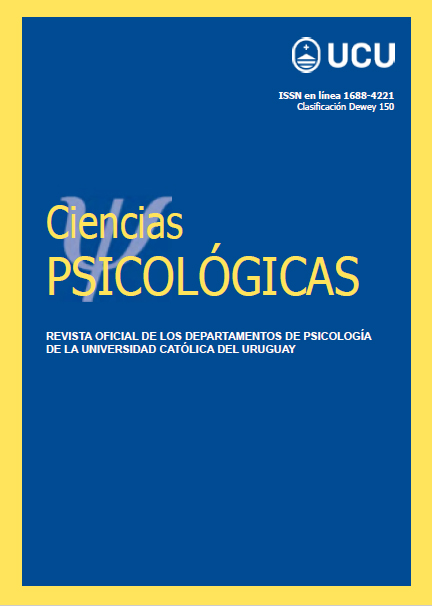The Covered Face of Stereotypes: Benevolent Sexism in the Reproduction of Social Inequalities
DOI:
https://doi.org/10.22235/cp.v19i2.4533Keywords:
stereotypes, sexism, intergroup relations, gender, prejudiceAbstract
This study aimed to replicate the Stereotype Content Model instrument in a Brazilian sample of 245 individuals, mapping the stereotypes produced by participants from southern Brazil and adding the gender variable to the social groups evoked. The instrument compares the dimensions of Warmth and Competence, which correspond to the sympathy or competitiveness that social groups elicit. The results showed that the differences were more frequently in favor of male groups. Female social groups were only seen as more competent and warmer than their male counterparts in the case of Unemployed, Poor, and Black Women. From the perspective of racism and gender, we discuss that stereotypes also uphold sexist norms, sometimes benevolent and sometimes hostile, as a way of transmitting traditional ideologies, encouraging the maintenance of social positions that are beneficial to the unequal social system.
Downloads
References
Allport, G. W. (1954). The nature of prejudice. Addison-Wesley.
Amorim, A. K. F., Conceição, A. C., Pereira, C. R., & Do Bú, E. A. (2024). O papel legitimador do conteúdo estereotípico para a diferença salarial entre homens e mulheres. Revista de Psicologia Da IMED, 16(1), 3-21. https://doi.org/10.18256/2175-5027.2024.v16i1.5170
Arruda, A. S., & Miklos, J. (2020). O peso e a mídia: estereótipos da gordofobia. LÍBERO, 23(46), 111-126. https://seer.casperlibero.edu.br/index.php/libero/article/view/1116
Bento, C. (2022). O pacto da branquitude. Companhia das Letras.
Böhm, R., Rusch, H., & Baron, J. (2020). The psychology of intergroup conflict: A review of theories and measures. Journal of Economic Behavior & Organization, 178, 947-962. https://doi.org/10.1016/j.jebo.2018.01.020
Canton, E., Hedley, D., & Spoor, J. R. (2023). The stereotype content model and disabilities. The Journal of Social Psychology, 163(4), 480-500. https://doi.org/10.1080/00224545.2021.2017253
Conceição, A. C. (2020). O papel do conteúdo dos estereótipos na discriminação de gênero. Em M. E. O. Lima, D. X. D. França, & R. M. Ko. Freitag (Orgs.), Processos psicossociais de exclusão social (pp. 89–100). Editora Blucher. https://doi.org/10.5151/9786555060393-04
Couto, M. C. P. de P., & Koller, S. H. (2012). Warmth and competence: stereotypes of the elderly among young adults and older persons in Brazil. International Perspectives in Psychology: Research, Practice, Consultation, 1(1), 52-62. https://doi.org/10.1037/a0027118
Cuddy, A., Fiske, S., Kwan, V., Glick, P., Demoulin, S., Leyens, J., & Ziegler, R. (2009). Stereotype content model across cultures: Towards universal similarities and some differences. British Journal of Social Psychology, 48(1), 1-33. https://doi.org/10.1348/014466608X314935
Dametto, J., & Esquinsani, R. S. S. (2015). Mãe, mulher... professora! Questões de gênero e trabalho docente na agenda educacional contemporânea. Acta Scientiarum. Human and Social Sciences, 37(2), 149-155. https://doi.org/10.4025/actascihumansoc.v37i2.27127
Fiske, S., Cuddy, A., Glick, P., & Xu, J. (2002). A model of (often mixed) stereotype content: Competence and warmth respectively follow from perceived status and competition. Journal of Personality and Social Psychology, 82(6), 878-902. https://doi.org/10.1037/0022-3514.82.6.878
Fiske, S., & North, M. (2015). Measures of stereotyping and prejudice: Barometers of bias. Em G. J. Boyle, D. H. Saklofske, & G. Matthews (Eds.), Measures of personality and social psychological constructs (pp. 120–138). Academic Press. https://doi.org/10.1016/B978-0-12-386915-9.00024-3
Fernandes, F. (1965). A Integração do Negro na Sociedade de Classes (6th ed.). Editora Contracorrente.
Fonseca, L. K. da S., de Araújo, L. F., Salgado, A. G. A. T., Gomes, H. V., de Jesus, L. A., & Alves, M. E. da S. (2022). Representações sociais a respeito da velhice LGBT sob a ótica de mulheres lésbicas brasileiras. Salud & Sociedad, 12, e3508. https://doi.org/10.22199/issn.0718-7475-3508
Formiga, N., Golveia, V., & Santos, M. N. (2002). Inventário de sexismo ambivalente: Sua adaptação e relação com o gênero. Psicologia em Estudo, 7(1), 25-34. https://doi.org/10.1590/S1413-73722002000100013
Giger, J. C., Orgambídez-Ramos, A., Gonçalves, G., Santos, J., & Gomes, A. (2015). Evidências métricas da adaptação da escala de dominância social numa amostra portuguesa. Avaliação Psicológica, 14(1), 143-151. https://doi.org/10.15689/ap.2015.1401.16
Gonzalez, L. (2020). Por um feminismo afro-latino-americano: Ensaios, intervenções e diálogos. Zahar.
Kilomba, G. (2019). Memórias da plantação: Episódios de racismo cotidiano. Cobogó.
Kleppesto, T. H., Czajkowski, N. O., Sheehy‐Skeffington, J., Vassend, O., Roysamb, E., Eftedal, N. H., Kunst, J. R., Ystrom, E., & Thomsen, L. (2024). The genetic underpinnings of right‐wing authoritarianism and social dominance orientation explain political attitudes beyond Big Five personality. Journal of Personality, 92(6), 1744-1758. https://doi.org/10.1111/jopy.12921
Liaquat, U., & Jost, J. T. (2023). Expectations about system justification predict the ideological gap in attitudes towards immigrants. Scientific Reports, 13, 11309. https://doi.org/10.1038/s41598-023-38347-8
Lippmann, W. (1922). Public opinion. The Free Press.
Locatelli, P. A. P. C., & Cavedon, N. R. (2014). Representações sociais e a captação de pessoas para trabalhar com idosos. RACE: Revista de Administração, Contabilidade e Economia, 13(1), 9-34. https://periodicos.unoesc.edu.br/race/article/view/2619
Ho, A., Sidanius, J., Pratto, F., Levin, S., Thomsen, L., Kteily, N., & Sheehy-Skeffington, J. (2012). Social dominance orientation: Revisiting the structure and function of a variable predicting social and political attitudes. Personality and Social Psychology Bulletin, 38(12), 1610-1627. https://doi.org/10.1037/e514892012-001
Jost, J. T., & Banaji, M. R. (2020). The role of stereotyping in system-justification and the production of false consciousness. Em J. T. Jost (Ed.), A Theory of System Justification (pp. 70-95). Oxford University Press.
Nicolas, G., Bai, X., & Fiske, S. T. (2022). A spontaneous stereotype content model: Taxonomy, properties, and prediction. Journal of Personality and Social Psychology, 123(6), 1243-1263. https://doi.org/10.1037/pspa0000312
Nodari, S. (2021). Nomes e pronomes na Língua Portuguesa: a questão sexista no idioma e na academia. Revista Estudos Feministas, 29, e74197. https://doi.org/10.1590/1806-9584-2021v29n374197
Operario, D., & Fiske, S. T. (2001). Effects of trait dominance on powerholders' judgments of subordinates. Social Cognition, 19(2), 161-180. https://doi.org/10.1521/soco.19.2.161.20704
Pires, E. (2021). A blogosfera materna é branca: Trabalho, feminismos, raça e classe na blogosfera materna brasileira. Revista Ártemis: Estudos de Gênero, Feminismo e Sexualidades, 31(1).
Reis, M. (2019). O pacto narcísico da casa-grande: A representação das mulheres negras a partir de Lélia Gonzalez e Gilberto Freyre. Humanidades em Diálogo, 9, 93-101. https://doi.org/10.11606/issn.1982-7547.hd.2019.154274
Rodrigues, R. A. (2023). The Invisible Workforce: Domestic Workers and Labor Rights in Brazil [Tese de Doutorado, American University]. ProQuest Dissertations & Theses. https://search.proquest.com/openview/3e4cc1c98cf3fbe7f2d7f2ae4e033f83/1?pq-origsite=gscholar
Rubin, M., Owuamalam, C. K., Spears, R., & Caricati, L. (2023). Social identity explanations of system justification: Misconceptions, criticisms, and clarifications. European Review of Social Psychology, 34(1), 268-297. https://doi.org/10.1080/10463283.2023.2184578
Silva, L. L., & de Oliveira Nunes, E. S. (2022). Reflexões sobre língua (gem) neutra no português brasileiro. Crátilo, 15(1), 113-133. https://revistas.unipam.edu.br/index.php/cratilo/article/view/3767
Schofield, T. P., Suomi, A., & Butterworth, P. (2022). Is the stereotype of welfare recipients associated with type of welfare state regime? A cross‐national meta‐regression of the stereotype content model. Journal of Applied Social Psychology, 52(4), 201-209. https://doi.org/10.1111/jasp.12843
Tajfel, H. (1984). Intergroup relations, social myths and social justice in social psychology. Em H. Tajfel (Ed.), The social dimension (Vol. 2, pp. 695–715). Cambridge University Press.
Tajfel, H., & Turner, J. C. (1979). An integrative theory of intergroup conflict. Em W. G. Austin, & S. Worchel (Eds.), Organizational identity: A reader (pp. 56–65). Books/Cole. https://doi.org/10.1093/oso/9780199269464.003.0005
Thiele, M. (2022). Categories, stereotypes, images, and intersectionality. New Perspectives on Imagology, 30, 277-297. https://doi.org/10.1163/9789004513150_015
Yzerbyt, V., Rocher, S., & Schadron, G. (1997). Stereotypes as explanations: A subjective essencialistic view of group perception. Em R. Spears, P. J. Oakes, N. Ellemers, & S. A. Haslam (Eds.), The social psychology of stereotyping and group life (pp. 21–50). Blackwell.
Published
How to Cite
Issue
Section
License
Copyright (c) 2025 Ciencias Psicológicas

This work is licensed under a Creative Commons Attribution 4.0 International License.
















